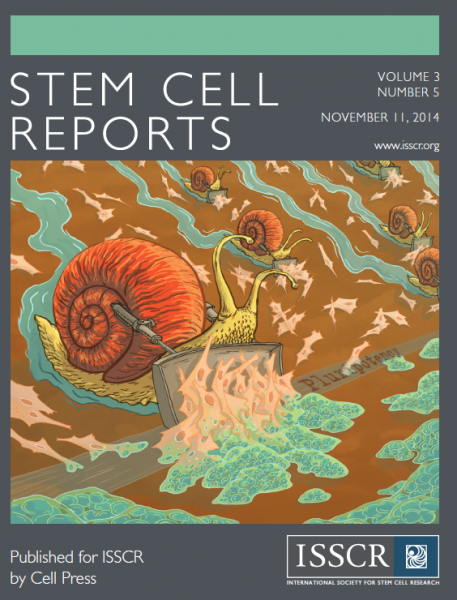PNCA illustration major Anna Lensch forges ongoing artistic partnership with Daley Lab
 An illustration by Pacific Northwest College of Art (PNCA) sophomore Anna Lensch was selected to be the cover art for the November issue of Stem Cell Reports, a scientific journal published by Cell Press for the 4,000+ members of the International Society for Stem Cell Research.
An illustration by Pacific Northwest College of Art (PNCA) sophomore Anna Lensch was selected to be the cover art for the November issue of Stem Cell Reports, a scientific journal published by Cell Press for the 4,000+ members of the International Society for Stem Cell Research.
The cover art depicts a legion of “snail-plows” (each symbolizing the protein SNAI1 or SNAIL) pushing connective tissue cells over the “goal line” of pluripotency—indicating that the cells have gained an ability to generate many other cell types.
“The illustration shows the hard work that goes behind changes from one cell to another cell,” said Lensch, who drew the image with black ink and painted it digitally in Photoshop. “SNAIL pushes the cells toward transformation.”
The artwork is related to findings published in this month’s Stem Cell Reports. The research was led by Dr. Juli Unternaehrer while she was a postdoctoral fellow in the laboratory of Dr. George Daley, a physician-scientist who studies and treats blood diseases at Boston Children’s Hospital.
Lensch completed a research-turned-artistic internship in the Daley Lab during her senior year of high school and has continued to collaborate on cover art ever since. This is the second submission to be accepted; the first appeared in the journal Trends in Cell Biology four years ago.
“I sensed Anna wasn’t really interested in doing bench research, so we let her loose to capture and interpret our work from the artist’s perspective, and she produced several remarkable watercolors,” said Dr. Daley, a core member of the Harvard Stem Cell Institute.
“We realized she could be a tremendous resource for winning covers for our papers, and so with most of our accepted papers, we now seek her creative input, and we’re hoping that means more and more covers in the future,” he added. “We don’t always win the cover, but working with her has certainly energized our efforts.”
“Even if I’m not a scientist myself, I love hearing about incredible scientific discoveries and translating them into art,” Lensch said. “When it came to this commission, I was able to use a lot of techniques that I’ve been learning at PNCA. Being able to enact concepts from class on a personal project, I feel like I was able to put out my most professional image to date.”
 Lensch grew up surrounded by science because of her father, Dr. M. William Lensch, who studied blood stem cells for many years in the Daley Lab before becoming the Executive Director of Harvard University’s Department of Stem Cell and Regenerative Biology. Father and daughter team up for the cover art projects, which have included designing pomade packaging for a gene that regrows hair in mice and creating a zebrafish-themed painting containing multiple, intricately placed clues for how a certain mutation impacts blood formation.
Lensch grew up surrounded by science because of her father, Dr. M. William Lensch, who studied blood stem cells for many years in the Daley Lab before becoming the Executive Director of Harvard University’s Department of Stem Cell and Regenerative Biology. Father and daughter team up for the cover art projects, which have included designing pomade packaging for a gene that regrows hair in mice and creating a zebrafish-themed painting containing multiple, intricately placed clues for how a certain mutation impacts blood formation.
“To pull out interesting angles from a paper and to sit with an artist, one I know very well in some ways but who sees the world very differently, and to come up with these ideas is very satisfying,” said Dr. Lensch. “It is so fulfilling to see a young person like Anna see the value of the scientific enterprise and to get how it translates into her world.”
“I think there’s a false dichotomy between art and science: both are essentially grounded in creativity and that desire to explore the world and in some cases even reject what we see,” he continued. “Artists and scientists have to get jobs and publish, but the part that really is motivating is how it feels to be a part of the creative process.”
Anna Lensch plans to equally pursue illustration along with narrative filmmaking, her other passion, for a career.
“I’ve submitted so many covers and it was definitely surprising and very rewarding to finally have one chosen,” Lensch said. “I’ve learned that even if you can’t find illustration work right away to seize opportunities when they arise because you never know when you’re going to be published.”
Research cited: Daley, G. Q. and Unternaehrer, J. J., et al. The Epithelial-Mesenchymal Transition Factor SNAIL Paradoxically Enhances Reprogramming. Stem Cell Reports. November 11, 2014. DOI: 10.1016/j.stemcr.2014.09.008
